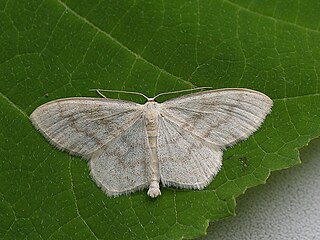
The cream wave is a moth of the family Geometridae. The species was first described by Adrian Hardy Haworth in 1809. It is found in forest and woodland regions, feeding on grasses and small plants such as dandelion.

Scopula rubiginata, the tawny wave, is a moth of the family Geometridae. The species was first described by Johann Siegfried Hufnagel in 1767.

Euxoa adumbrata, the sordid dart, is a moth of the family Noctuidae. The species was first described by Eduard Friedrich Eversmann in 1842. In North America it is found across northern Canada from Quebec to western Alaska, south to the northern parts of the United States, and in the mountains to Colorado. It is also found in Greenland, the coastal areas of Scandinavia and the Ural. It was recently recorded from Denmark, although this includes Euxoa lidia, which some authors regard to be a valid species.
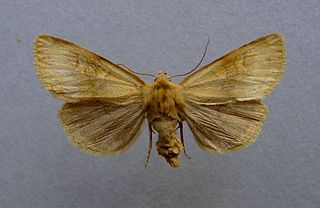
Xestia lorezi is a moth of the family Noctuidae. It is found in northern Europe and the Alps. Subspecies lorezi is found in the Alps on altitudes between 1,700 and 2,500 meters. Subspecies kongsvoldensis is found in Fennoscandia and northern Russia. Outside of Europe, there are four more subspecies, ssp. sajana in the Sayan Mountains, ssp. katuna in the Altai mountains, ssp. monotona in Yakutia and ssp. ogilviana in Yukon and Alaska.

Scopula limboundata, the large lace-border, is a moth of the family Geometridae. It was described by Adrian Hardy Haworth in 1809. It is found in North America east of the Rocky Mountains. There is a single and unconfirmed record from Great Britain.

Scopula cacuminaria, the frosted tan wave, is a moth of the family Geometridae. The species was first described by Herbert Knowles Morrison in 1874. It is found in North America across southern Canada, from the Maritimes to southern British Columbia, south to Texas.

Scopula junctaria, the simple wave, is a moth of the family Geometridae. The species was first described by Francis Walker in 1861. It is found in the whole of Canada and the northern United States, south to Maryland, Arizona, and California.

Scopula frigidaria is a moth of the family Geometridae. It was described by Heinrich Benno Möschler in 1869. It is found from Fennoscandia to the Kamchatka Peninsula and in northern North America, where it occurs across the boreal forest region, from Alaska across the Northwest Territories and Nunavut to Newfoundland, and in the mountains south to southern Wisconsin, Alberta and British Columbia.

Scopula incanata is a moth of the family Geometridae. It is found from north-eastern Europe and the Caucasus to southern Siberia and northern Mongolia.

Scopula virgulata, the streaked wave, is a moth of the family Geometridae. The species was first described by Denis & Ignaz Schiffermüller in 1775. It is found from most of Europe to central Asia and northern Mongolia.
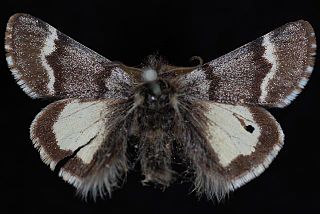
Leucobrephos brephoides, the scarce infant moth, is a moth of the family Geometridae. The species was first described by Francis Walker in 1857. It is found in North America from Yukon to Labrador and south to New York and southern Alberta and British Columbia. The habitat consists of open mixed wood forests of the boreal and mountain region.

Scopula inductata, the soft-lined wave, is a moth of the family Geometridae. It was described by Achille Guenée in 1857. It is found in North America, from Newfoundland to the coast of British Columbia, north to the Northwest Territories, south to Alabama and Utah.
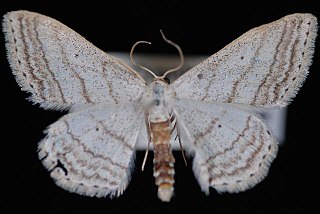
Scopula ancellata, the angled wave moth or pointed-winged wave, is a moth of the family Geometridae. It was described by George Duryea Hulst in 1887. It is found in North America from Quebec west to the Northwest Territories and British Columbia and south to Michigan, Indiana and Arizona. The habitat consists of mixed wood and coniferous forests.
Scopula arenosaria is a moth of the family Geometridae. It was described by Staudinger in 1879. It is found in south-eastern Russia.

Scopula corrivalaria is a moth of the family Geometridae. It is found from Japan, Korea, China and the Russian Far East through Siberia and Russia to western Europe. In Europe, it ranges from northern Central Europe to the Mediterranean. The habitat consists of marshes and wet meadows.
Scopula fuscata is a moth of the family Geometridae. It was described by George Duryea Hulst in 1887. It is found in North America from south-western Saskatchewan west to British Columbia and south to California and Arizona. The habitat consists of montane areas, including foothills.

Scopula luteolata is a moth of the family Geometridae. It is found in western North America. In Canada, the range extends from the mountains of south-western Alberta, north to Banff and west to Vancouver Island. In the United States, it has been recorded from Arizona, California, Montana, Nevada, New Mexico, Oregon, Washington and Wyoming. The habitat consists of montane wooded and shrubby openings and edges in forests.
Scopula perlata, the cream wave, is a moth of the family Geometridae. The species was first described by Francis Walker in 1861. It is found in Australia, as well as Indonesia.

Scopula umbelaria is a moth of the family Geometridae described by Jacob Hübner in 1813. It is found in the Benelux, France, Italy, Germany, Switzerland, Austria, the Czech Republic, Slovakia, Hungary, Slovenia, former Yugoslavia, Romania, Poland and Russia. In the east, the range extends to the eastern part of the Palearctic realm.
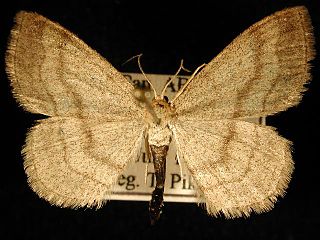
Scopula siccata is a moth of the family Geometridae first described by James Halliday McDunnough in 1939. It is found in North America from northern Colorado north through Wyoming, western Montana and Idaho to southern British Columbia and south-western Alberta. The habitat consists of dry slopes in mountainous areas.
















